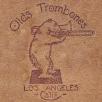
It's a bear!
Early 1960's Olds TIS Bass Trombones (Jerry Rosa)
| Both of these trombones were owned by Jerome "Jerry"
Rosa,
(1918-2008). Jerry (also known as "Happy") had a long
career
as a
professional trombonist beginning in the late 1930's. I've been able to
find information indicating that he played with Van Alexander, Red
Norvo, Ray Miller, Jimmy Dorsey, Jerry Gray, Woody Herman, Claude
Thornhill, Les Brown, and Dick Stabile. The picture at the
left is
from a military ID issued to him when he played with Les Brown and his
Band of Renown on Bob Hope's Operation Holly USO tour to Vietnam in
1968. I acquired these
horns, along with a collection
of photos and other memorabilia, from
Jerry's nephew (also named Jerry) in 2013. I spotted the newer of the two on eBay, thinking it was TIS George Roberts model. Fortunately, the seller was close enough (and cooperative enough) that I was able to make arrangements to look it over in person. On closer examination, I discovered that it differed somewhat from the production GR model (more on that below). More importantly, my visit with the seller gave me the opportunity to see the other horn (not yet offered on eBay) and the rest (photos, etc.) and to work out a deal to make an offer on the entire lot once the auction for the one horn ended (assuming, of course, that I was high bidder). |
|
| Jerry Rosa December, 1968 |
1963 Olds Dual-Bore TIS Bass Trombone
Bore: .554"-.565" (14.1 mm-14.4 mm), .585" (14.9 mm) attachment
Bell: 10" (254 mm)
This horn's serial number is 4231xx, which dates it to 1963. It's identical to the TIS George Roberts model with one important difference - the slide is dual-bore .554"/.565". The engraving makes no mention of George Roberts - just "F. E. Olds and Son" and "Fullerton Calif.". What looks like a mouthpiece adapter is actually the end of a leadpipe - it does not seat all the way in.
 Overall View Front |
 Engraving |
 End Crook |
 Case |
 Overall View Back |
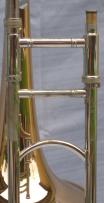 Braces and Tuning Mechanism |
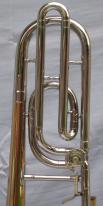 F-attachment |
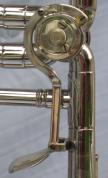 Valve Detail |
1960 Olds TIS Prototype(?) Bass Trombone
Bore: .554"-.565" (14.1 mm-14.4 mm), .585" (14.9 mm) attachment
Bell: 10" (254 mm)
This horn carries a serial number of 3430xx, which dates it to 1960. It's an odd hybrid, clearly derived the then-current S-20 Super bass trombone, but incorporating some features that are not typical of an S-20 but were used on later Olds bass trombone designs (the George Roberts models, the S-24G, and the P-24G). There's residual solder around many of the joints, indicating that it might not have been given a final finish at the factory. The unique design and unfinished appearance make me think that it might have been a prototype of some sort. It's from the time period when the original George Roberts Olds was being developed, so it's possible that this instrument is somehow related to that project.
Features unique to this horn:
Bell:
The bell is dimensionally identical (based on mute insertition depth)
to the optional 10" bell available on the S-20, but is made
of rose brass (like those on the later Olds basses) rather
than
the yellow brass normally used for S-20 bells..
J-crook:
Like the bell, the j-crook is dimensionally identical to the
corresponding part on an S-20, but is made of the same material (nickel
silver) used on later Olds basses rather than the yellow brass found on
the S-20.
F-attachment: As
with the j-crook, the S-20's yellow brass has been replaced with nickel
silver (as used on later models). Also, rather than the "flat wrap"
found on S-20's, this horn's f-attachment uses a "traditional wrap"
like the one used on the Olds Opera and later Olds basses.
Bell
Brace: On an S-20, the bell brace is postioned so that the player's
thumb wraps around the brace to reach the f-attachment lever. This
horn's bell brace is placed closer to the back bow, so the
player's thumb does not have to reach over it to actuate the
f-attachment. This is the arrangement used on later Olds basses.
Tuning
Mechanism: Like the S-20, this horn is tuning-in-slide, but it lacks
the S-20's adjustment screw and "third brace" (the one between
the
outer slide tubes). The adjustment screw's function is now performed by
a collet-style clamp installed in the lower tuning
sleeve.
The third brace was simply deleted. These changes were clearly made to
lighten the slide - understandable, since the S-20's slide is quite
heavy, even by bass trombone standards. While this approach
was effective (the slide is about 40 grams lighter), it
results in
a slide that is less forgiving of rough use. Overtightening the clamp
could crush the outer slide, and the lack of a third brace could cause
alignment issues. The production TIS George Roberts bass used the
conventional adjustment screw/third brace design, and subsequent Olds
bass trombone designs abandoned the TIS concept completely.
I'd be inclined to call this instument unique, but I have seen one similar instrument. Back in 2008, someone showed up at Bones West with something that was almost identical; according to my records, its serial number was 418xxx, so it was somewhat newer than this one.
A note about the engraving: Olds used this style for a few years in the late 1950's and early 1960's. I've seen it on Opera trombones, French horns, and bass trombones.
I'd be inclined to call this instument unique, but I have seen one similar instrument. Back in 2008, someone showed up at Bones West with something that was almost identical; according to my records, its serial number was 418xxx, so it was somewhat newer than this one.
A note about the engraving: Olds used this style for a few years in the late 1950's and early 1960's. I've seen it on Opera trombones, French horns, and bass trombones.
 Overall View Front |
 Engraving |
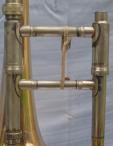 Braces and Tuning Mechanism |
 Overall View Back |
 End Crook |
|||
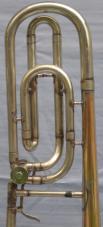 F-Attachment Front |
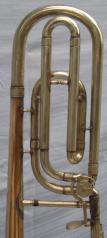 F-Attachment Back |